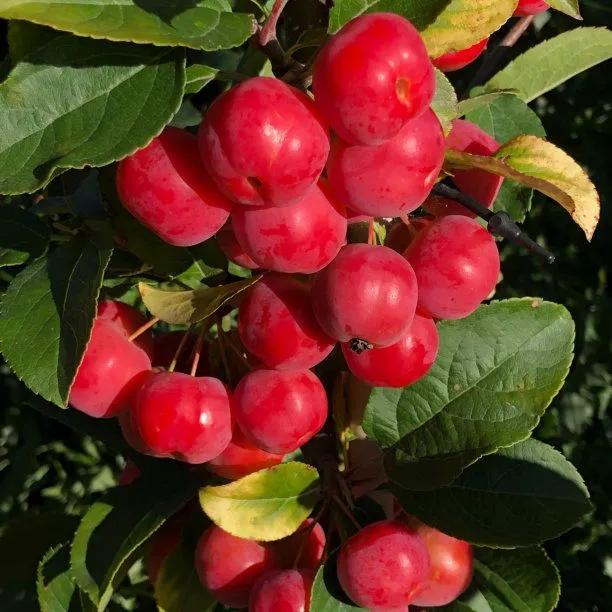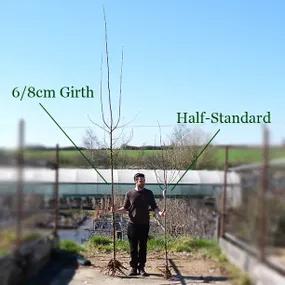Red Sentinel Crab Apple, Large Trees
Honest Delivery PricesDelivered in Large Sizes
- Asian. Pink flowers, fading to white.
- Persistent red fruit
- Good for kitchen use, jelly etc.
- Sharp flavour
- Max. Height: 7m
- Bareroot Delivery: Nov-Mar
- RHS Award of Garden Merit
Recommended extras
Description
Malus robusta Red Sentinel: Bareroot Red Sentinel Crab Apple Trees in Standard Sizes
Red Sentinel crab apple trees have plentiful clusters of blood-red fruits that stay on the branches deep into the winter months. Starting in late April, the purple buds produce a mass of single, white (variably tinged with pink), strongly scented flowers that make a delicate, balanced display with the bright green leaves, rather than engulfing the whole tree.
Red Sentinel's fruits are quite small, numerous and well suited for use in purC)es, jellies and other apple dishes that require a sharper taste. If you leave them on the branch to brighten up your garden in winter, birds usually won't start pecking away at them until after they have been well softened by a few hard frosts.
It can reach a height of about 6-7 metres tall, highly recommended for small, city gardens.
John Downie and Golden Hornet are classic pollinators for orchard apple trees, but if scab is a problem in your area, this variety is well worth a try.
Browse our range of crab apple trees.
Delivery season: Crab apple trees are delivered bareroot during late autumn and winter, approximately November-March inclusive.
Choosing a size: Small trees are cheaper, easier to handle and more forgiving of less than ideal aftercare, so they are best for a big planting project. If instant impact is your priority, or if you are only buying a few plants for use in a place where it is convenient to water them well in their first year, then you may as well use bigger ones. All our bareroot trees are measured by their height in centimetres above the ground (the roots aren't measured).
Features:
- Height: 6-7m
- Soil: Any well drained
- Use: Specimen, small gardens, urban
- Colour: White flowers with a little pink in April-May
- Persistent fruit stay on branches long into winter
- Exceptional disease resistance, especially against scab
- RHS Award of Garden Merit
- Bareroot delivery only: November-March
Growing Red Sentinel Crab Apple Trees
Any well drained soil, tolerates partial shade and urban pollution well.
Planting Instructions
Notes on planting Malus Red Sentinel:
Crabapples are tough plants that thrive in any moderately fertile soil. They tolerate shade well, although we recommend planting them in full sun to get the best display of flowers and fruit. Although a moist, well drained site is ideal, crabapples like heavy clay and don't mind a bit of waterlogging in winter.
They won't grow in deep shade and may struggle in very poor dry soil.
Prepare your site before planting:
It is good to dig over the site where you plant a tree several months in advance. Kill the weeds first: for tough weeds like nettles, brambles and ground elder, you will usually need a weed-killer to get rid of them. When you dig the soil over, remove stones and other rubbish and mix in well rotted compost or manure down to the depth of about 2 spades.
Watch our video on how to plant a tree for full instructions.
Remember to water establishing trees during dry weather for at least a year after planting.
Tree Planting accessories:
Prepare your site for planting by killing the weeds and grass.
You can buy a tree planting pack with a wooden stake & rubber tie to support the tree and a mulch mat with pegs to protect the soil around the base of your tree from weeds and drying out.
We suggest that you use mycorrhizal "friendly fungi" on the roots of all newly planted large trees: if your soil quality is poor, we strongly recommend it.
You can also improve your soil with bonemeal organic fertiliser.
Did You Know?
Malus x robusta is a hybrid of Malus baccata (Siberian crab apple) and Malus prunifolia, both native to Asia. It was bred by Notcutts Nursery in the 1950's.
The RHS has given this tree an Award of Garden Merit, for beauty and ease of cultivation, and an Award of Merit for cuttings of its flowering stems when used in a display.
Standard trees are measured by their girth in centimetres 1 metre above ground level: their trunk's waist measurement. Unlike sapling trees and hedge plants, standards aren't measured by their height, which will vary quite a bit both between and within species.
So, a 6/8cm standard tree has a trunk with a circumference of 6-8cm and an 8/10 standard has a trunk 8-10cm around. This measurement makes no difference to the tree's final height.
On average, standard trees are 2-3.5 metres tall when they arrive, but we cannot tell you precisely how tall your trees will be before we deliver them.




